Passenger Train Cars (USA): Types, History, Dimensions
Last revised: August 21, 2024
By: Adam Burns
Traveling by train dates back to the genesis of railroads when these fledgling operations were still finding their way in a young America.
As John Stover's book, "The Routledge Historical Atlas Of The American Railroads" (New York: Routledge, 1999), points out the very first passenger cars were designed from stagecoaches.
More than three decades would pass before modern conveniences like the dedicated sleeper, diner, parlor, and other accommodations found their way onto a train.
Many credited to George Pullman who recognized the need for such amenities prior to the Civil War. He spared no expense to ensure his company provided the very best for passengers, going so far staffing cars with his own employees.
The Pullman Company became legendary for its services and remained a leader in car innovation through the streamliner era.
Its equipment in the post-World War II featured everything one could ever expect from air-conditioning to dome-viewing.
Unfortunately, Pullman's greatest competitors proved unconquerable, the airliner and automobile. Amtrak's debut in the spring of 1971 signaled the end of an era with the loss of Pullman, on-time service, and most first-class accommodations.
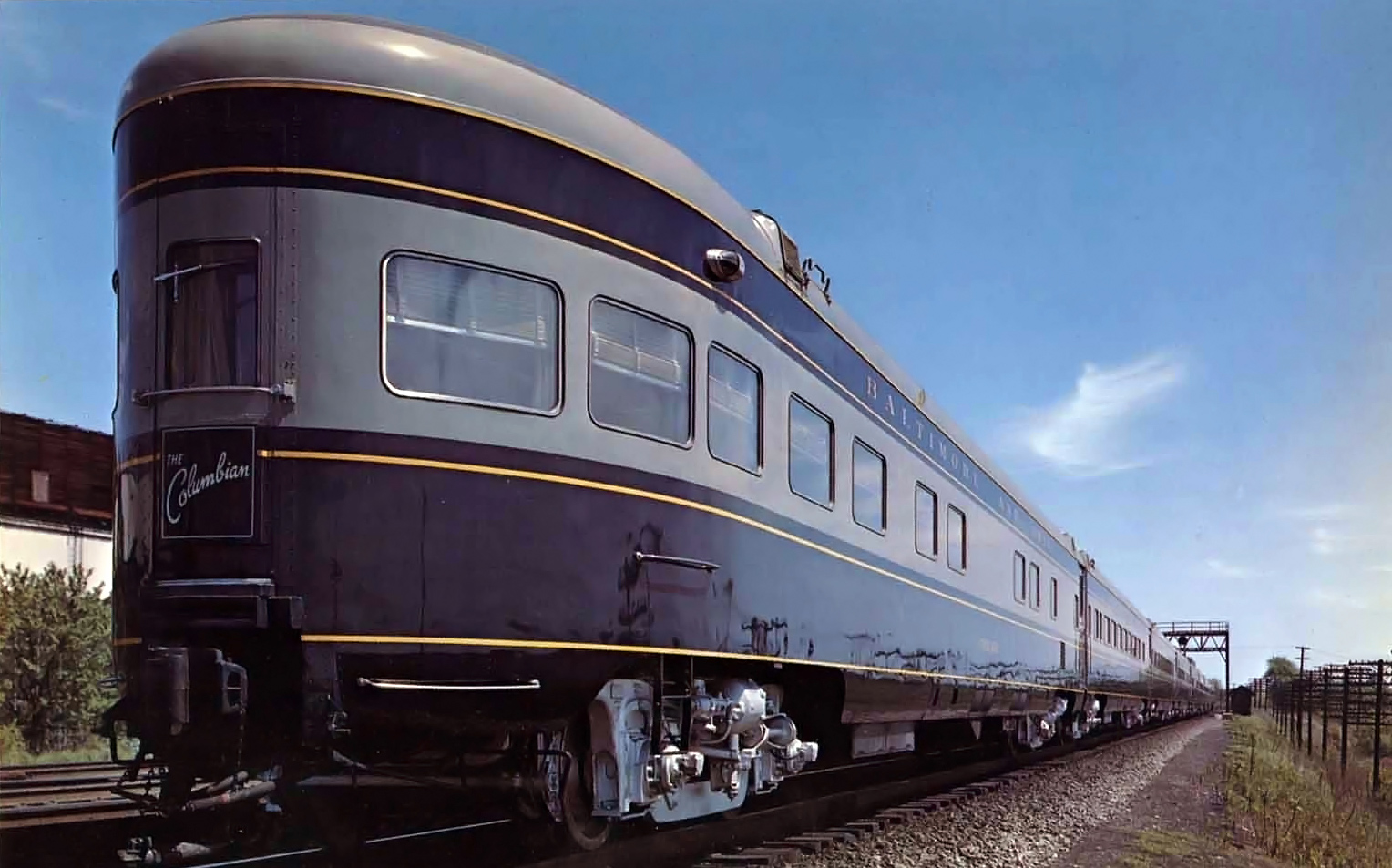 A Baltimore & Ohio company photo featuring the beautiful observation-buffet-lounge "Chicago" bringing up the rear of the "Columbian," its secondary service between New York - Washington/Baltimore - Chicago.
A Baltimore & Ohio company photo featuring the beautiful observation-buffet-lounge "Chicago" bringing up the rear of the "Columbian," its secondary service between New York - Washington/Baltimore - Chicago.Overview
When the South Carolina Canal & Railroad Company's 0-4-0, Best Friend of Charleston, made history by carrying a trainload of paying customers on December 25, 1830 transportation in America was forever changed.
The railroad faced stiff opposition from the onset, particularly by canal owners and interests which clearly understood the iron horse's threat to their future well-being. Smear campaigns were rampant and somewhat effective early on.
However, the railroad's speed was simply unmatched; the fastest luxury canal boats traveled no faster than 6 mph while the Best Friend of Charleston, as noted by the book "Railroads In The Days Of Steam" from the editors of American Heritage, could travel at speeds between 30-35 mph on its own while the locomotive could handle six cars loaded with fifty passengers at an impressive 21 mph!
Blazing fast for that era the locomotive came with a bonus; it not require frequent stops for food, water, and rest like a horse.
Early systems like the SCC&RR and B&O essentially utilized modified stagecoaches for paying customers at the start. However, this was a relatively short-lived phenomenon as will be discussed in more detail later.
Baltimore & Ohio
Interestingly, beyond the basic coach railroads never bothered to advance passenger comfort to great lengths.
There were some improvements carried out with seating, interior utilization, and basic accommodations but nothing approaching true relaxation until George Pullman developed his self-proclaimed "hotel car."
The Baltimore & Ohio, our country's first common-carrier, held a long list of industrial "firsts" during its illustrious history. One of its many pioneering endeavors was to introduce the first true passenger car during August of 1830.
The railroad had originally launched horsepower service between Baltimore (Mount Clare) and Carrollton Viaduct (about 1.5 miles) on January 7th that year.
However, as the months wore on passengers became increasingly dissatisfied with the bumpy and uncomfortable accommodations the crude coaches offered.
In his excellent book, "The Railroad Passenger Car," author August Mencken points out that B&O's chief engineer in 1831, Jonathan Knight, noted:
"...[it is] absolutely necessary to the comfort of the passengers that carriages used for their conveyance should be mounted upon springs or some equivalent feature."
So that summer the B&O sought to remedy this issue by constructing dedicated passenger coaches with such features in mind. The August 14, 1830 issue of the Baltimore Gazette notes the following:
"Yesterday, agreeable to notice, the splendid railroad car Ohio was exhibited for examination in front of the City Hotel where it remained several hours and was universally admired by a large concourse of citizens.
This is the sixth car of the class as the Pioneer made by that judicious and capable mechanic, Mr. Imlay, for the Baltimore & Ohio Railroad Company, and, in addition to the general advantages of beauty, comfortable arrangement and excellence of construction, which are common to the whole class, it is improved by the additional convenience of two seats the whole length of the car, with a common back, placed on and along the middle of the top, which is extended several inches in breadth over each side to increase the room, so the occupants may pass freely.
The seats and back between them are cushioned and over them is an awning of canvas supported by a neat, light but sufficiently strong iron frame. The whole arrangement and finish of the top is very handsome and adds much to the general appearance as well as convenience of the car."
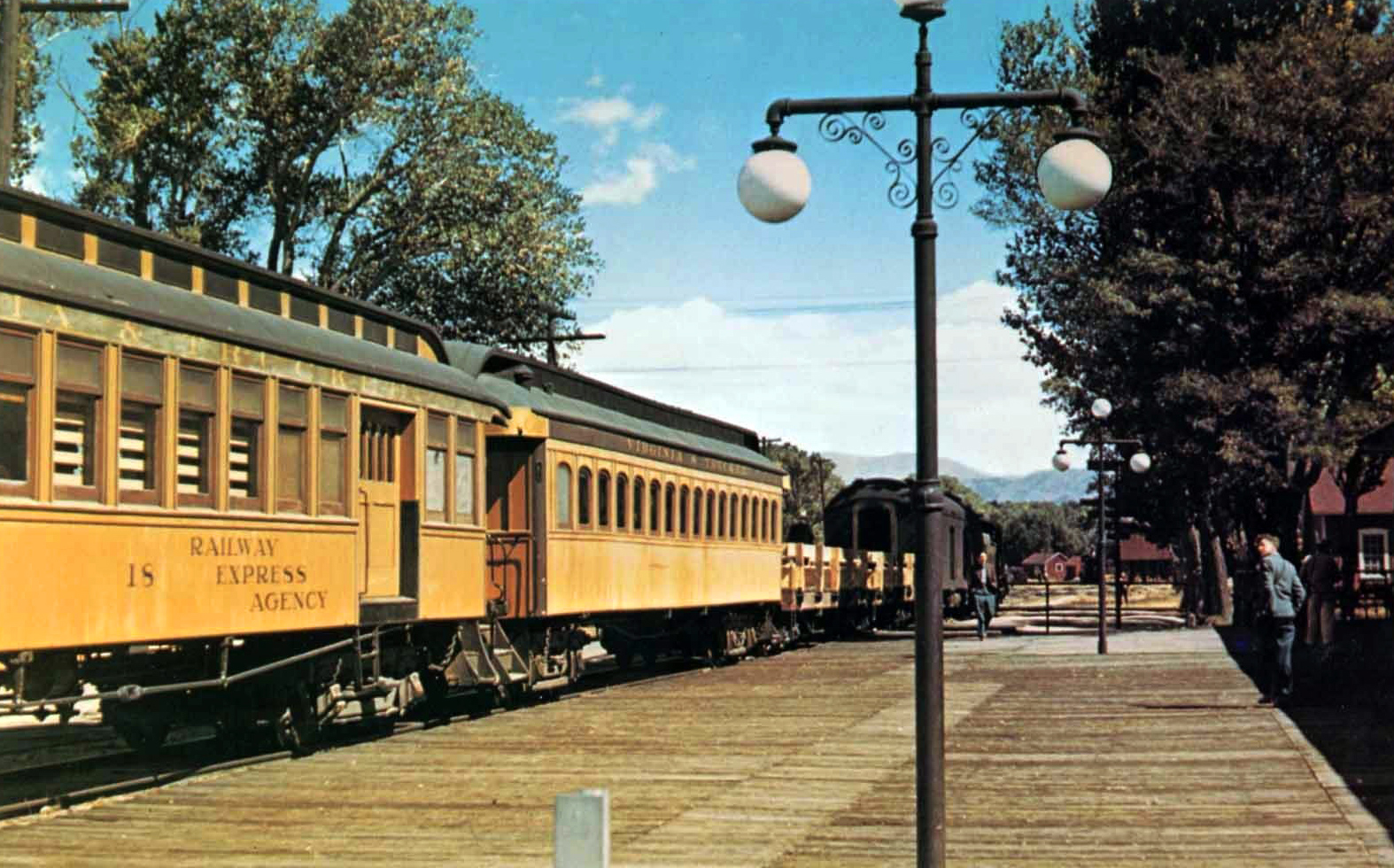 Early passenger equipment regularly featured a clerestory, as seen here on the Virginia & Truckee coach #19 and combination #18 at Carson City, Nevada on September 21, 1941. The train is pulled by 4-4-0 #11 ("Reno") and 4-6-0 #27.
Early passenger equipment regularly featured a clerestory, as seen here on the Virginia & Truckee coach #19 and combination #18 at Carson City, Nevada on September 21, 1941. The train is pulled by 4-4-0 #11 ("Reno") and 4-6-0 #27.The B&O also placed the modern coach in service during 1834. It was the work of Ross Winans, featuring a center aisle running longitudinally with seating to each side that carryied double-trucks (two-axle suspension assemblies with one placed at each end of the car).
While only a prototype all future passenger cars were based from this design. Through the 1850's engineers began experimenting with other seating perks such as reclining, suspension, and plush backs although these did not become widespread features until late that century.
If one wished to enjoy a meal during long-distance travels the only way to do so was via a track-side restaurant located at various station points.
The train would have to wait for passengers to finish their meals which delayed the trip by up to an hour.
However, in the West it gave rise to the successful chain of Harvey House restaurant and hotels owned by the Fred Harvey Company, most famously along the Atchison, Topeka & Santa Fe's main line.
The topic of on-board dining was another which had been discussed as early as 1838 but no real efforts were made to add such features for decades.
Mr. Mencken's book notes the first use of a diner-like car was the restaurant car, two of which were put into service on the Philadelphia, Wilmington & Baltimore in 1863. These were converted coaches with half the car featuring a bar and steam box.
George Pullman
The food was prepared off-train at terminals and then brought aboard and served during layovers. George Pullman is credited with introducing the first true diner, named the Delmonico, completed in 1867.
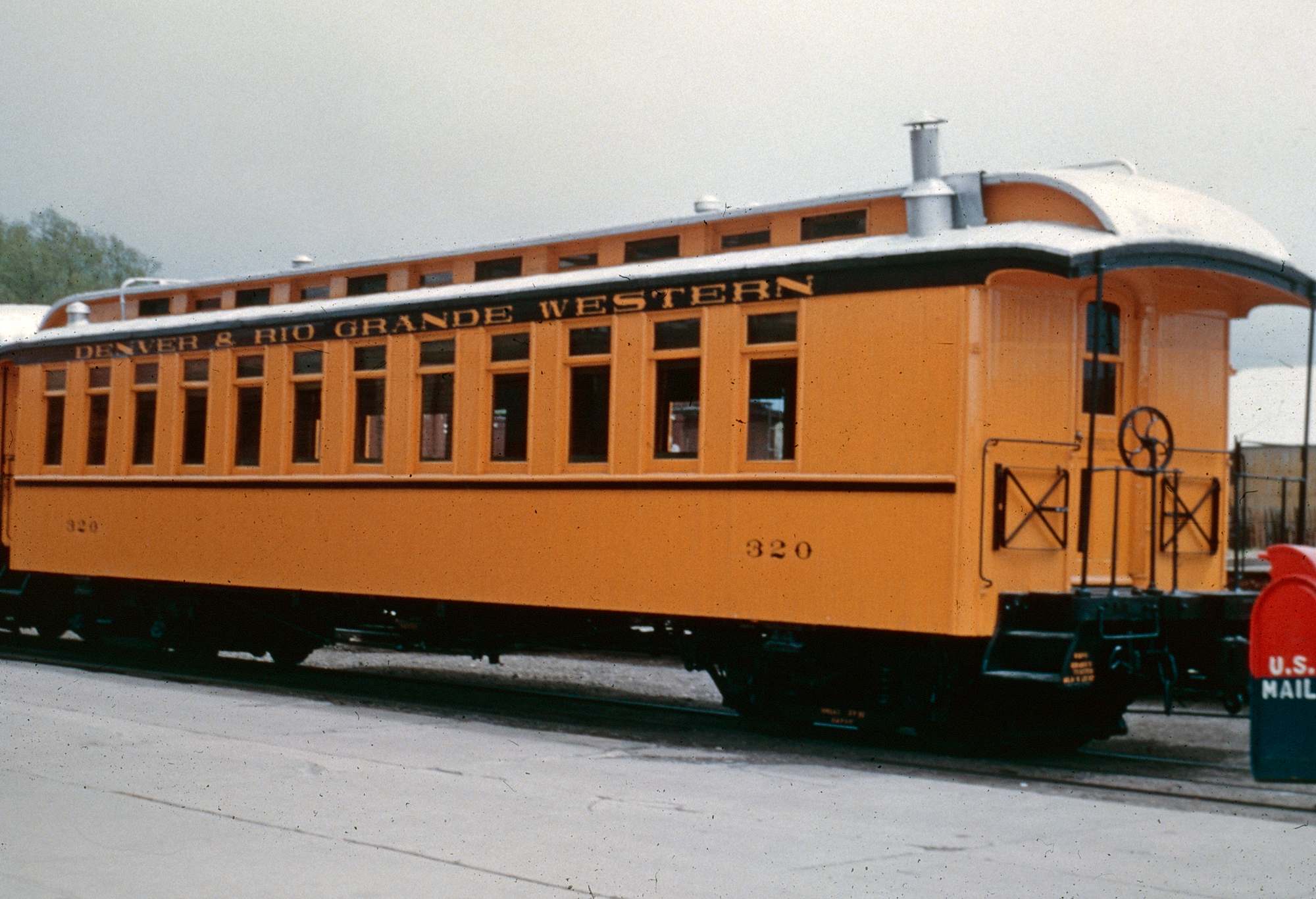 A handsome Rio Grande narrow-gauge wooden coach (44-seat), #320, is seen here next to the depot at Alamosa, Colorado on May 31, 1957. Author's collection.
A handsome Rio Grande narrow-gauge wooden coach (44-seat), #320, is seen here next to the depot at Alamosa, Colorado on May 31, 1957. Author's collection.And he may not have invented the sleeper but its transformation into an accommodating and successful service is thanks largely to his vision.
As Joe Welsh, Bill Howes, and Kevin Holland note in their book, "The Cars Of Pullman," rudimentary versions had been available since the late 1830's and more than a dozen patents for various types sprang up over the next few decades.
However, all provided only the most basic of service. After Pullman had experienced these crude arrangements for himself during an 1853 trip between Westfield and Buffalo, New York, he quickly concluded this simply could not do. In 1859 he constructed the first dedicated sleeper from a former coach named, "Old No. 9."
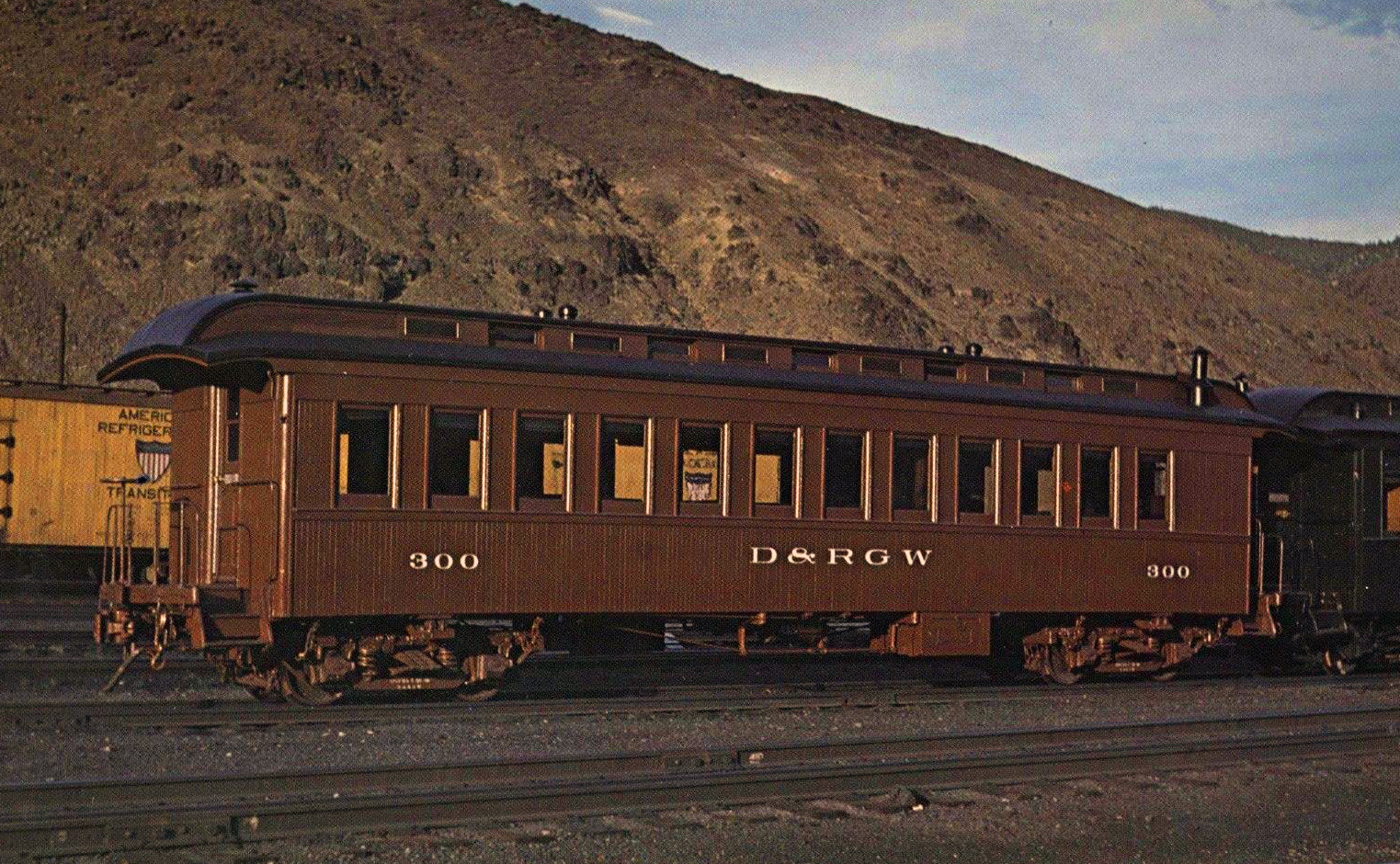 Another early clerestory car, wooden Rio Grande narrow-gauge 44-seat coach #300 at Salida, Colorado on July 7, 1940. The car was originally built by Jackson & Sharp's Delaware Car Works of Wilmington, Delaware in 1881 as #76.
Another early clerestory car, wooden Rio Grande narrow-gauge 44-seat coach #300 at Salida, Colorado on July 7, 1940. The car was originally built by Jackson & Sharp's Delaware Car Works of Wilmington, Delaware in 1881 as #76.For the period in which it was built the car featured a surprising array of amenities including upper and lower berths (These provided sleeping arrangements by either pulling down a bunk-like apparatus from the ceiling or folding down the plush seats.
Privacy was offered via heavy curtains.), candles for lighting, and a small lavatory at each end (featuring a toilet, tin wash basin, and drinking faucet). No. 9 was later purchased by the Chicago, Alton & St. Louis, making its initial run into Chicago on September 1, 1859.
This first car was not a dedicated sleeper as Pullman had simply converted it from a former CA&StL coach (carrying a pair of two-axle trucks). That changed in 1865 when he unveiled the first true sleeper named, The Pioneer.
This particular "hotel car" featured upper and lower berths, compartments at each end, ornate woodworking (Mr. Welsh, Mr. Howes, and Mr. Holland point out that up to half of a Pullman's construction costs at this time could be attributed directly to interior work) a washroom, complete carpeting and upholstery, larger end-platforms, and even heating via floor ducts.
In February of 1867 the Pullman Palace Car Company was incorporated (later shortened to the Pullman Company in 1900) and continually raised the standard for what would be described as first-class accommodations.
Virtually all modern rail travel conveniences can be attributed to Pullman, or his company, as he strove to provide the very best.
In 1874 the first parlor car was introduced followed by the first electrically-lit car in 1882, making its debut on the Pennsylvania Railroad.
One of the important advancements in rail travel was the vertical end-frame developed by Henry Sessions in November of 1887.
He was Pullman's superintendent and his friction plate solved the issue of dangerous swaying between rail car platforms, which made it much safer for passengers to pass from car to car while the train was in motion.
The device was basically the first modern enclosed vestibule although Sessions disclaimed credit for it as part of his invention. Whatever the case the PRR put the first into service that same year. With passengers now able to move freely about all of the convinces of a hotel on wheels could be enjoyed.
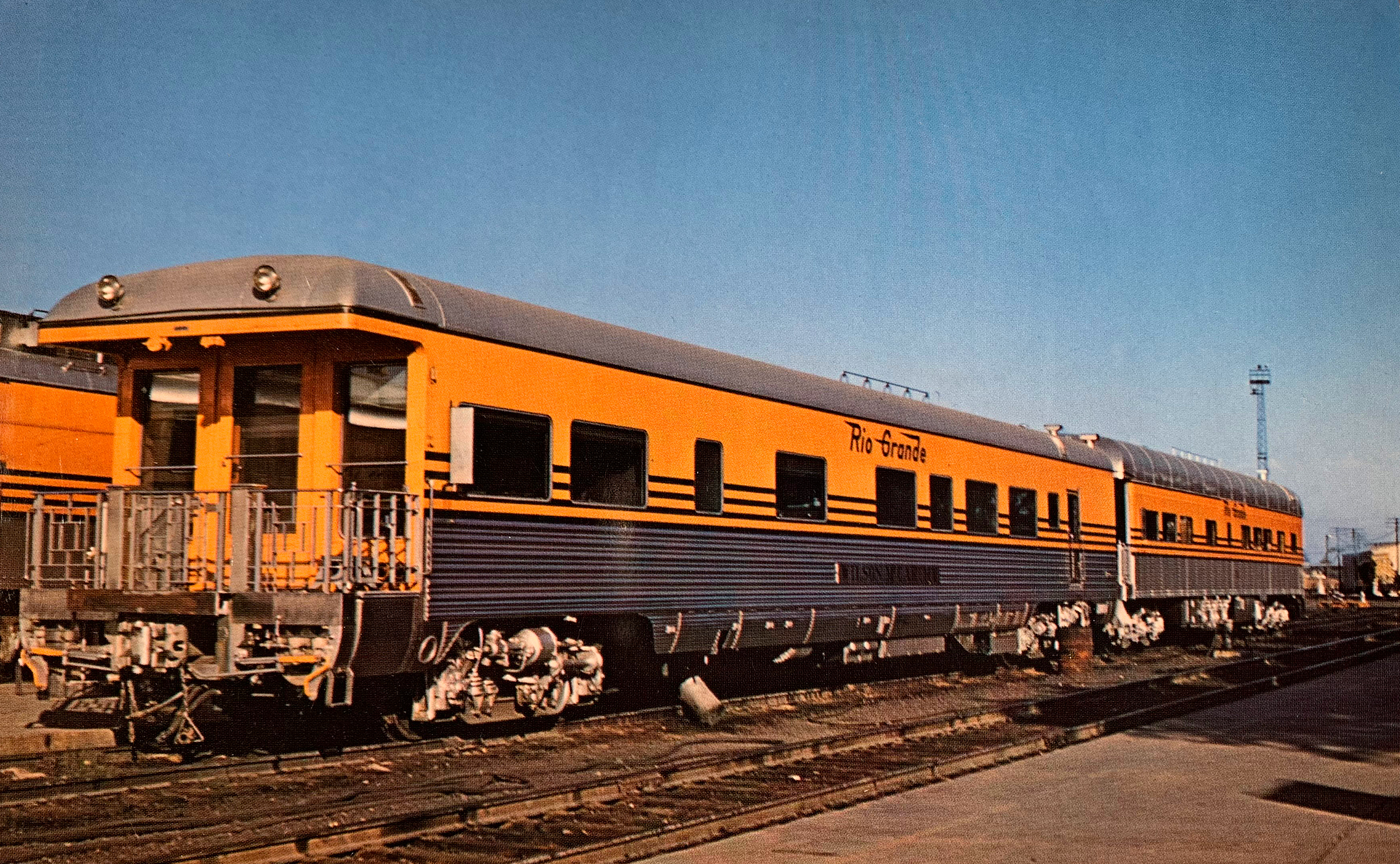 Rio Grande office cars #100 and #102 (named the "Wilson McCarthy") layover in Grand Junction, Colorado in September, 1956. Jackson Thode photo. Author's collection.
Rio Grande office cars #100 and #102 (named the "Wilson McCarthy") layover in Grand Junction, Colorado in September, 1956. Jackson Thode photo. Author's collection.Car Construction And The Modern Age
Even by the late 19th-century most equipment was still built primarily with wood except for support structures (frame, trucks, and other necessary structural components) made of early steel. The use of steel gave rise to "heavyweight" cars comprised entirely from metal, hence their name.
Steel not only increased strength but also reduced the chance of fire. The first use of an all-metal car was theorized as early as 1846 by H.L. Lewis to be built from wrought iron.
Various railroads experimented with the design thanks to its safety improvements in the areas of telescoping (this event occurs during a derailment/accident when one car/locomotive plows over the frame and through the carbody of another due its continued momentum) and general structural strength.
At the turn of the 20th century all-steel, heavyweights gained widespread acceptance (Pullman introduced its first in 1907) and by 1910 were in regular use throughout the industry.
The streamliner era of the 1930's saw the last great advancement in passenger car comfort and convenience, brought about by the downturn in business during the Great Depression. One of the first was air-conditioning.
Pullman is credited with originally testing this technology in 1929 on a retrofitted car called the McNair. However, as well-known historian Herb Harwood, Jr. points out in his book, "Royal Blue Line: The Classic B&O Train Between Washington And New York," Pullman had trouble with the development, which dated back to 1927.
Once again the Baltimore & Ohio is recognized in this area. The railroad worked with inventor Willis Carrier (who went on to found the Carrier Corporation, one of the most successful company's in the field that remains in business today) during the summer of 1929 to install air-conditioning in one of its coaches.
More tests followed in the spring of 1930 utilizing the Colonial-series diner, Martha Washington, at which point the railroad felt the technology was ready for regular service aboard the Columbian. Following additional refinements the Columbian was credited as the first fully air-conditioned train on May 24, 1931.
The final improvements came in the area of streamlining when Union Pacific released its all new M-10000, a product of Pullman and the Winton Engine Company, for its nationwide tour on March 2, 1934.
Car Types
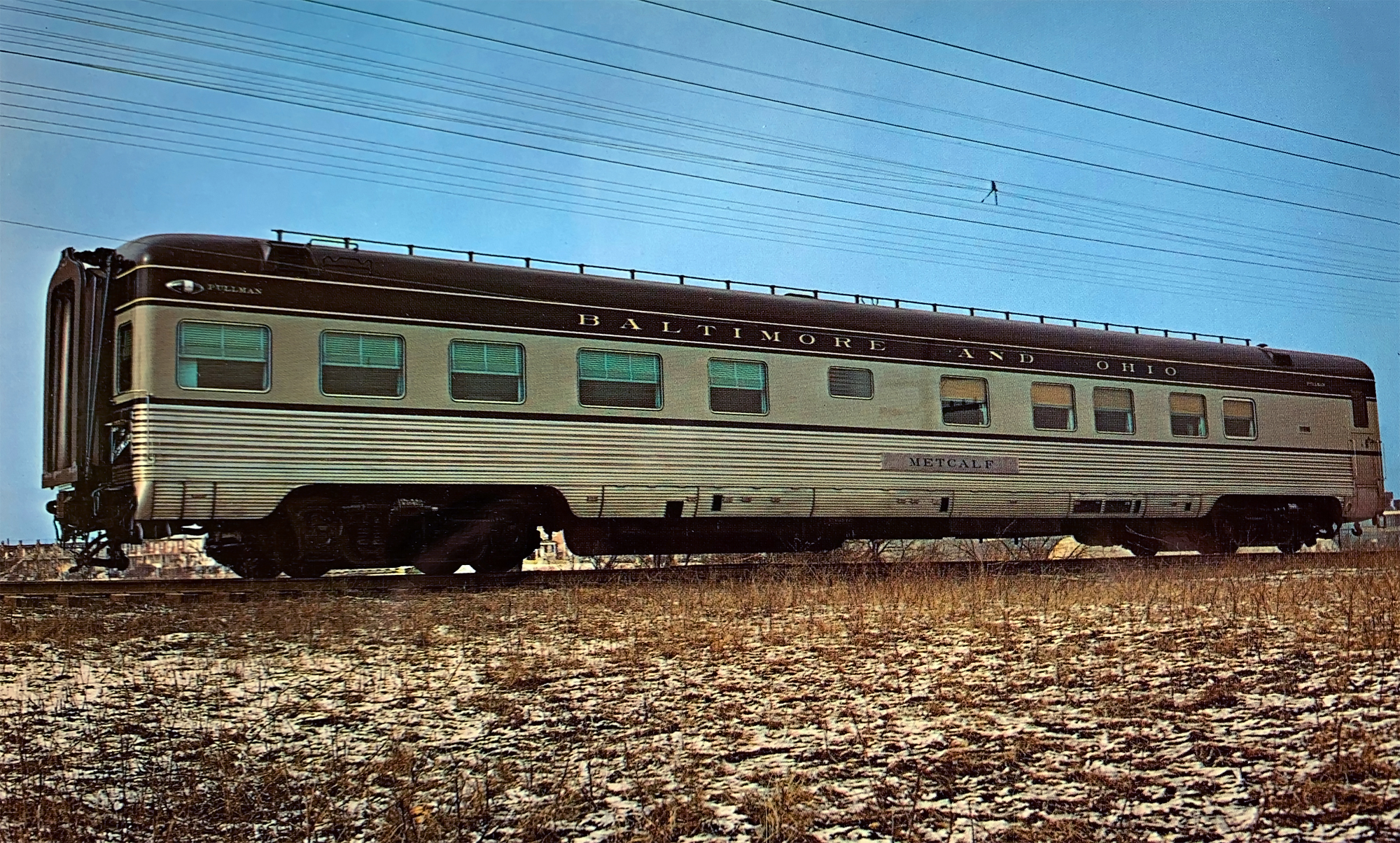 In this Baltimore & Ohio publicity photo, Pullman sleeper-buffet-lounge-observation car "Metcalf" (named for Metcalf, Illinois) is showcased in the early 1950's. The car was assigned to B&O's "Ambassador" service (Baltimore - Detroit).
In this Baltimore & Ohio publicity photo, Pullman sleeper-buffet-lounge-observation car "Metcalf" (named for Metcalf, Illinois) is showcased in the early 1950's. The car was assigned to B&O's "Ambassador" service (Baltimore - Detroit).Streamliners
The streamliner age did not necessarily bring about new car designs (aside from the dome) but did revolutionize rail travel by offering travelers bright, vibrant decors with better utilization of interior space.
The other visual improvement appeared on the exterior where carbodies were made entirely smooth featuring a curved roof-line and windows only slightly recessed, as seen above in the B&O's observation-buffet-lounge Chicago which operated at the tail-end of the Columbian.
From a structural standpoint the introduction of aluminum cut down on weight considerably while offering the same strength.
Alas, by the 1950's railroads could not quell the losses brought about by other modes of transportation. As a result orders nearly stopped and along with it, new innovation and ideas.
Within a decade railroads were greatly cutting back their passenger fleets an incident which ultimately led to the formation of the government-sponsored Amtrak in 1971.
Today, Amtrak's service has continued to improve but the days of relaxing in a rear observation car or enjoying a five star meal prepared by a chef are no more.
Contents
Recent Articles
-
New York Murder Mystery Dinner Train Rided On The A&A!
Dec 03, 25 09:52 AM
While its regular excursions are popular with families, railfans, and casual travelers alike, the railroad’s themed experiences—especially its Murder Mystery Dinner Train—have made it a standout desti… -
Pennsylvania Murder Mystery Dinner Train Rides On The M&H
Dec 03, 25 09:40 AM
Among their special events, the railroad’s murder mystery dinner train experiences are perennial crowd-pleasers—part theater, part culinary outing, and entirely memorable. -
New Mexico Christmas Train Rides In Santa Fe!
Dec 03, 25 09:26 AM
Among the Sky Railway's most popular offerings is a family-friendly Christmas outing, Pablo’s Holiday Express, which turns the historic Lamy Depot into a winter wonderland each holiday season.



